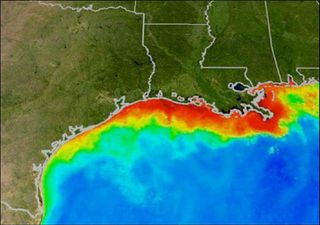How Big Will the Gulf's Dead Zone Get This Year?

The predicted size of this year's dead zone in the Gulf of Mexico depends on whom you ask. One forecast model predicts an unusually small area of oxygen-depleted water, while another predicts an extent in line with the recent average.
The reason for the difference: The more conservative prediction, made by researchers at the University of Michigan, only takes into account the nutrient-rich agricultural run off from the Mississippi River watershed this spring. While the other prediction, which comes from a Louisiana group, takes leftovers from the prior year's nutrient pollution into account.
These predictions are important because the loss of oxygen is bad news for the animals that live in these waters, and the dead zone threatens commercial and recreational fishing in the gulf.
This spring has been a drier-than-average one for the continental U.S., and the Mississippi River Valley and some other interior states experienced a May that was one of the 10 driest on record, according to U.S. weather records. [Mightiest Floods of the Mississippi River]
Less precipitation means less run-off to carry nutrients down the Mississippi and into the Gulf. Nutrients, specifically nitrogen, are responsible for the dead zone.
University of Michigan forecasters are predicting a dead zone of about 1,197 square miles (3,100 square kilometers), well below the average of 6,000 square miles (15,540 square kilometers) for the past five years, according to the U.S. National Oceanic and Atmospheric Administration.
Meanwhile, researchers in Louisiana have made a much less optimistic prediction. Louisiana Universities Marine Consortium and Louisiana State University scientists are estimating the dead zone will reach 6,213 square miles (16,092 square km).
Sign up for the Live Science daily newsletter now
Get the world’s most fascinating discoveries delivered straight to your inbox.
The Louisianan model factors in excess nitrogen brought into the Gulf the prior year and tucked into bottom sediments, for a "carryover effect."
The nitrogen pollution fertilizes algae in the water, which bloom, then die and sink. The microbes that decompose the dead algae suck oxygen out of the water. What's more, the lighter freshwater flowing into the Gulf forms a layer above the heavier salt water, this prevents oxygen from mixing into the deeper water.
Officials expect to announce the actual size of this summer's dead, or hypoxic, zone between July 27 and Aug. 3. Last year, the dead zone measured 6,765 miles (17,521 square km).
Follow Wynne Parry on Twitter @Wynne_Parry or LiveScience @livescience. We're also on Facebook & Google+.

